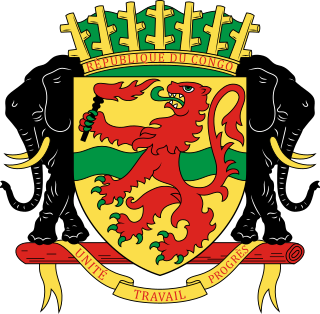Related Research Articles

The Republic of the Congo is located in the western part of central Africa, on the Equator. Congo has several important ports. The Republic of the Congo covers an area of 342,000 km², of which 341,500 km² is land while 500 km² is water. Congo claims 200 nautical miles (370 km) of territorial sea.

Kouilou is a department of the Republic of the Congo. Covering the country's coastline, it has an area of 13,650 square kilometres and at the start of 2023 it was home to about 97,362 people. The department borders Niari Department, the commune of Pointe-Noire, and internationally, Gabon and the Cabinda area of Angola.

The Kouilou-Niari River—also spelled Kwilu, Kwila, or Kwil—is the most important river flowing to the Atlantic Ocean of the Republic of the Congo coast. Moreover, its entire drainage area is completely in the Republic of the Congo. The river is called the Kouilou River while flowing in the coastal region of the Kouilou till the Sounda gorges. Upstream from the gorges, its name is the Niari River and it flows through the Niari Valley. The river combines with the Louessé, the Loudima and the Bouenza River and eventually flows into the Atlantic Ocean. It covers about 560 km from its origin in the Batéké Plateau of the Congo to its mouth at the coast.

Niari is a department of the Republic of the Congo in the western part of the country. It borders the departments of Bouenza, Kouilou, and Lékoumou, and internationally, Gabon, the Democratic Republic of the Congo, and the Cabinda portion of Angola. The regional capital is Dolisie.

Pointe-Noire is the second largest city in the Republic of the Congo, following the capital of Brazzaville, and an autonomous department and a commune since the 2002 Constitution. Before this date it was the capital of the Kouilou region. It is situated on a headland between Pointe-Noire Bay and the Atlantic Ocean. Pointe-Noire is the main commercial centre of the country and has a population of 1,420,612 inhabitants in 2023.

The Departments of the Republic of the Congo are divided into 86 districts and 6 communes; which are further subdivided into urban communities and rural communities ; which are further subdivided into quarters or neighborhoods (quartiers) and villages. Note the departments of Brazzaville and Pointe-Noire are made of 1 commune each, then divided in urban districts (arrondissements).
The Republic of the Congo is divided into 12 départements (départements). Departments are divided into communes and/or districts; which are further subdivided into urban communities and rural communities ; which are further subdivided into quarters or neighborhoods (quartiers) and villages.

Chilochromis duponti is a species of cichlid endemic to riverine habitats in the Chiloango River basin of Cabinda Province of Angola and the Democratic Republic of the Congo, the Kouilou-Niari River and lower Loeme River in the Republic of Congo, and the Nyanga basin and upper Ngounie River which is part of the Ogooué system in Gabon. The main part of its diet is aquatic vegetation, largely algae, but small amounts of invertebrates are eaten. It is spawns on to the substrate. This species reaches a length of 30 centimetres (12 in) SL. It is the only currently known member of its genus. The specific name honours the Édouard Dupont (1841-1911), a Belgian geologist who was a pioneer of the geological exploration of the Congo Basin and a director of the Brussels Museum.

Madingo-Kayes is a district in the Kouilou Region of far south-western Republic of the Congo. The capital lies at Madingo-Kayes.

Mvouti is a district in the Kouilou Region of far south-western Republic of the Congo. The capital lies at Mvouti.
Vili (Civili) is one of the Zone H Bantu languages, grouped with the Kongo clade.

Mimeresia debora, the Debora's harlequin, is a butterfly in the family Lycaenidae. It is found in Sierra Leone, Ivory Coast, Ghana, Nigeria, Cameroon, Gabon, the Republic of the Congo, the Central African Republic, the Democratic Republic of the Congo and Uganda. Its habitat consists of forests.

Oil and gas dominate the extraction industries of the Republic of the Congo, also referred to as Congo-Brazzaville. The petroleum industry accounted for 89% of the country’s exports in 2010. Among African crude oil producers in 2010, The Congo ranked seventh. Nearly all of the country's hydrocarbons were produced off-shore. The minerals sector is administered by the Department of Mines and Geology. Presently no major mining activities are underway, although there are some small-scale domestic operations. However, the country does have numerous large-scale undeveloped resources. The country has recently attracted a strong influx of international companies seeking to tap into the vast mineral wealth.

China–Republic of the Congo relations refer to the bilateral relations between China and Republic of the Congo. On September 10, 1960, Republic of the Congo and the Republic of China (Taiwan) established diplomatic relations. On February 22, 1964, the Republic of Congo switch recognition to the People's Republic of China as the sole legitimate government of China.
MagIndustries is a Canadian potash mining company operating in the Republic of Congo, majority owned by China-based Evergreen Holding Group.
Kore Potash is a mining company incorporated in the United Kingdom developing a potash project in the Republic of Congo.
Hinda is a district in the Kouilou Department of Republic of the Congo.
Nzambi is a district in the Kouilou Region of Republic of the Congo.
Since 2011, Tchiamba-Nzassi is a district of the Pointe-Noire Department in the Republic of the Congo. The seat is located in the urban community of Tchiamba-Nzassi.
References
- ↑ "Sintoukola Potash Project, Kouilou, Congo". mining-technology.com. 2013. Retrieved 2013-06-18.